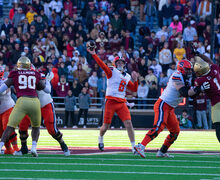How did the media get Trump wrong?
Moriah Ratner | Staff Writer
On campaign trail, Donald Trump has vowed to "open up" libel laws, relaxing rules that enables him to sue media organizations critical of him and his policies easier.
In light of the surprising presidential election result, news organizations are trying to understand why they weren’t able to predict Donald Trump’s victory.
Before Election Day, political website FiveThirtyEight forecasted that Democratic candidate Hillary Clinton had a 70 percent chance of winning, while The New York Times’ Upshot saw her as an 85-percent favorite. As election night progressed, however, it was evident that those predictions were wrong. Key swing states such Pennsylvania, Florida and Wisconsin, as well as Rust Belt states such as Michigan that were expected to go to Clinton all flipped to Trump.
Philip Seib, professor of journalism and public diplomacy at the University of Southern California, denounced the news media for not properly covering Trump and not treating him seriously.
“They missed the fact that there are so many people who are angry and worried about their jobs and dissatisfied with the state of the economy,” Seib said. “And the feeling was someone as outrageous as Trump could not win and therefore I think a lot of journalists didn’t bother doing the kind of coverage that they should have.”
Seventy-two percent of white men and 62 percent of white women without college degrees voted for Trump, according to exit poll data by The Washington Post. Trump also gained 52 percent of vote from college educated white men and 45 percent of white women.
Trump, a business mogul without previous political experience, enticed enthusiastic support from the constituent group, showcasing his ability to absorb frustrations in weakening manufacturing industries and changing demographics. Among other racial groups, 29 percent of Hispanic/Latino and Asians supported Trump, while 8 percent of black people did.
Dean Baquet, the executive editor of The New York Times, said in an interview with the Times that reporters working for the New York-based newspaper should have been out in the field, talking to diverse groups of people and reminding themselves that “New York is not the real world.”
Keith Bybee, a political science professor at the Maxwell School of Citizenship and Public Affairs at Syracuse University, said the failure is not about polling models, but rather in predicting outcomes in individual states.
David Mindich, a professor of media studies, journalism and digital arts at Saint Michael’s College, said the media gave Trump excessive free air time. The media streamed Trump’s speeches in their entirety live on television because of high ratings, particularly during the early stage of his candidacy.
The New York Times reported in March that Trump had benefited from nearly $2 billion worth of media attention, double of what Clinton earned.
Roy Gutterman, director of Tully Center for Free Speech and an associate professor in the S.I. Newhouse School of Public Communications, said by giving him “free media,” the media legitimized Trump’s candidacy.
At the same time, Gutterman said the media did well in exposing some of his flaws, including The Washington Post’s David Fahrenthold, who broke the story of Trump making lewd comments about his treatment of women that implied sexual assault and bragged he could get away with it because of his fame as he was preparing to film “Access Hollywood” with Billy Bush in 2005.
Yet to Trump supporters, his series of controversies did not outweigh the potential benefits brought by a Trump administration, Gutterman said.
Seib echoed Gutterman’s analysis.
“I think that the press reacted to Trump’s rhetoric and his behavior without fully considering that there might be people out there who didn’t care about his rhetoric and behavior but care about the fact that if he was elected he will turn everything upside down,” he said. “And some people were so desperate in terms of their economic situation that they wanted things turn upside down.”
Seib also highlighted Trump’s heavy reliance on social media, saying it has empowered him to disseminate his message by circumventing the traditional media. Though President Barack Obama used social media to reach out to constituents in his 2008 and 2012 campaigns, Seib said people haven’t seen an outsider candidate like Trump use it in the way he did.
Going forward, Bybee said it’s important to keep eyes on how Trump as president engages with the public using social media — particularly Twitter — and whether he will “open up” libel laws to make it easier for him to sue media organizations critical of him and his policies.
Gutterman expressed his hope that Trump’s campaign rhetoric does not translate into law and public policy when he becomes president.
“If it does, then we’re going to have some serious problems in the democracy,” Gutterman said.
Published on November 14, 2016 at 11:31 pm
Contact Satoshi: ssugiyam@syr.edu | @SatoshiJournal





